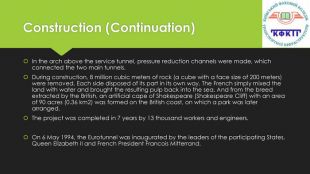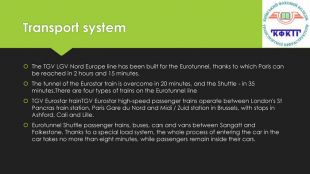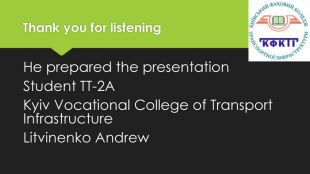Презентація до теми "Тунель в Лондоні"
Про матеріал
Презентація з придмету Англіська мова з теми тунель в лондоні до підручника Оксана Карплюк 10 -11 клас дуже корисна при вивченні придмету Анг мова 10-11клас
Перегляд файлу
Зміст слайдів
Середня оцінка розробки
Оцінки та відгуки
-
Thank you!
pptx
До підручника
Англійська мова (10-й рік навчання, рівень стандарту) 11 клас (Карпюк О.Д.)
Оцінка розробки


Безкоштовний сертифікат
про публікацію авторської розробки
про публікацію авторської розробки
Щоб отримати, додайте розробку
Додати розробку





![History(Continuation)Due to another financial problem, two years later, when a 250-meter-long test tunnel was dug, it was stopped again. In 1984, the governments of Great Britain and France came to the conclusion that construction was impossible without additional private funding. Financial costs regularly jumped. Of the four proposed, a plan most similar to the 1973 project was selected. It was published on January 20, 1986. On February 12, 1986, both governments signed an agreement to build a tunnel in Canterbury and ratified it in 1987. According to the project, the tunnel was to connect two cities: Calais on the French side [6] [non-authoritative source?] And Folkestone with English [7] [non-authoritative source?] (This path is not the shortest possible). The excavation was supposed to be in an easily pliable Cretaceous geological layer, so the tunnel had to run deeper than planned, about 50 meters below the bottom of the strait, and the southern part should run deeper than the northern. Because of this, the French first had to build a mine with a diameter of 50 m and a depth of 60 m to reach the sandstone. History(Continuation)Due to another financial problem, two years later, when a 250-meter-long test tunnel was dug, it was stopped again. In 1984, the governments of Great Britain and France came to the conclusion that construction was impossible without additional private funding. Financial costs regularly jumped. Of the four proposed, a plan most similar to the 1973 project was selected. It was published on January 20, 1986. On February 12, 1986, both governments signed an agreement to build a tunnel in Canterbury and ratified it in 1987. According to the project, the tunnel was to connect two cities: Calais on the French side [6] [non-authoritative source?] And Folkestone with English [7] [non-authoritative source?] (This path is not the shortest possible). The excavation was supposed to be in an easily pliable Cretaceous geological layer, so the tunnel had to run deeper than planned, about 50 meters below the bottom of the strait, and the southern part should run deeper than the northern. Because of this, the French first had to build a mine with a diameter of 50 m and a depth of 60 m to reach the sandstone.](/uploads/files/1122199/261655/283199_images/5.jpg)






















